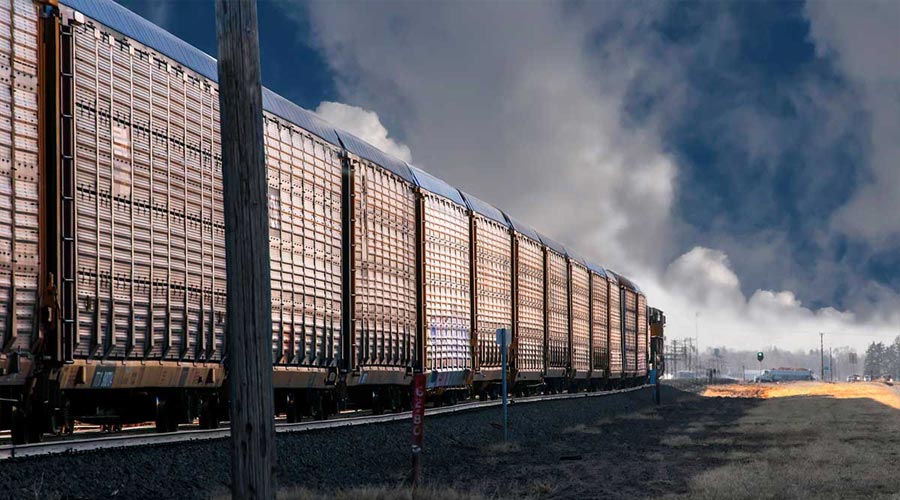Tallies, totals and other trend data in the freight transportation realm
2/22/2023
-6.1
FTR’s Trucking Conditions Index improved in December to -6.1 from November’s -7.94 reading, but the gain “resulted solely from a sharp drop in diesel prices during the month,” FTR officials said on Feb. 15. Changes in all freight-related components of the index — freight volume, capacity utilization, and freight rates — were unfavorable for carriers, they said, adding that the rates component was “the most negative it had been since May 2020.” FTR doesn’t expect any positive readings until late 2024.
0.7
The American Trucking Associations’ advanced seasonally adjusted For-Hire Truck Tonnage Index rose 0.7% in January after increasing 1% in December, ATA announced on Feb. 21. In January, the index equaled 117.1 (2015=100) compared with 116.2 in December. “I suspect that some of the gain is attributable to capacity coming out of the network, especially those carriers that primarily operate in the spot market and/or bought expensive used equipment in the last couple of years,” said ATA Chief Economist Bob Costello. “This would push more freight to contract carriers, which dominate this index. It could also be that freight bottomed and is coming up a little too. So, the gain is likely a little higher demand and a little less supply. Despite the increases in December and January, tonnage is still off 1.4% from its recent high in September.”
1
“Once again, the rails have moved from the business pages to [page 1], and it isn’t pretty. It was of course a self-inflicted wound, what appears to be an axle failure that came after passing a hot box detector. The timing could just about not be worse. After carrying water for the industry as the originator of what I have been calling the “Great Experiment,” Norfolk Southern is now bringing itself and its peers into the great political chasm, being attacked by both right and left, and middle. And, while not taking anything away from the severity of the accident, to compare it to Chernobyl (see Feb. 17 edition of the New York Times) does a disservice to everyone.” — Independent transportation analyst Tony Hatch in a Feb. 17 email to his clients titled “A Setback for the Great Experiment: NS and Ohio”
2
Two Class Is reached paid sick leave agreements this month. On Feb. 7, CSX announced it had reached agreements with the Brotherhood of Maintenance of Way Employes Division and the Brotherhood of Railway Carmen. On Feb. 10, CSX announced it had reached agreements with the International Association of Machinists and Aerospace Workers and the National Conference of Firemen and Oilers. On Feb. 20, Union Pacific Railroad announced that it had reached voluntary agreements calling for paid sick leave benefits for its employees who are members of the Brotherhood of Railway Carmen Division/TCU and the National Conference of Fireman and Oilers.
3.2
The shipments component of the Cass Freight Index® fell 3.2% month over month in January, Cass Information Systems Inc. reported on Feb. 14. On a seasonally adjusted basis, the index was unchanged from December — “better than expected with support from mild weather and improving auto production,” Cass officials said. “The Omicron wave of COVID was in full swing last January, which led to widespread absenteeism and supply-side pressure on shipments, and weather was more severe last January. So, the y/y comparison isn’t too meaningful, but the index rose 4.3% y/y.” Presuming normal seasonal patterns, the shipments component will be flat year over year in February and March, Cass officials said.
15
“When aggregating large retailer inventory data, we note the Q322 inventory/sales ratio reached the highest absolute level in 15+ years.” — Baird Equity Research’s Garrett Holland in a Feb. 22 report titled “Baird/Holland/Transports: Inventory Destocking: Retailers Making Progress, Clearing Excess Product”
37
Railroads and rail shippers “face higher new car pricing, driven by rail-car production cost, steel and tight component availability. Car availability has tightened as rail-car retirements have outpaced new deliveries for the 3rd consecutive year. Rail cars in storage are down and 37% of the stored fleet has been inactive for over 1 year and will either be scrapped or repurposed if economically possible. ... Tight equipment supply is supporting existing car pricing and lease renewal rates for both originations and renewals.” — Feb. 10 newsletter from RESIDCO titled “Constrained Supply Bolsters Equipment Rent & Values.” RESIDCO is a transportation equipment lessor and asset management company that operates and manages a freight-car and locomotive fleet.
47
For transports, fourth-quarter 2022 trends were “rougher as expected,” wrote Baird Equity Research’s Garrett Holland in a Feb. 16 report. “Only 47% of companies under coverage beat EPS estimates given the largely non-existent peak season,” Holland wrote. “Despite the weaker results, the median reaction was +2% post report and powered the 14.6% YTD rally for the DJTA (+661 bps vs. S&P 500). 2023 and 2024 EPS estimates declined 2% and 1%, respectively, post reporting.”
51.8
Equipment finance execs are more confident about business conditions this month than they were last month, according to the Equipment Leasing & Finance Foundation’s monthly confidence index for the equipment finance industry, issued Feb. 16. This month, confidence in the equipment finance market is 51.8, an increase from the January index of 48.5, according to the index. Said survey respondent Jim DeFrank, executive vice president and chief operating officer of Isuzu Finance of America Inc.: “We still see pent-up demand in the light and medium-duty segment of transportation. However, we feel it will wane by the third or fourth quarter of this year.”
400,000
“Last week, oil prices declined about 4% as higher crude and gasoline inventories were also reported. JPMorgan said in a note last week that the OPEC+ alliance could add 400,000 barrels per day to supply this year and Russian exports could recover by the middle of 2023.” — Ernie Barsamian, CEO and principal of The Tank Tiger, a Princeton, New Jersey, terminal storage clearinghouse, broker and intermediary in a Feb. 21 email message to clients
600 million
The Port of Manzanillo plans to invest about 600 million pesos this year to relieve heavy truck traffic near the port, officials port operator ASIPONA Manzanillo said in a Feb. 16 post on the port’s website. Project work includes developing a “second access area to the port,” building a new bridge and paving an alternate road. Nearly 42% of the containers handled by the Mexican port system, or 3.5 million twenty-foot equivalent units, arrive through Manzanillo — about 58% of the containerized cargo operated in the Mexican Pacific, port officials said.
